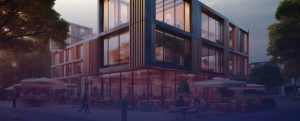Western Shopping Center Market Report
Western U.S. Retail Overview
The Southern California economy presents a unique profile, marked by spending trends that diverge significantly from national averages. A dominant factor is the region’s exceptionally high cost of living, particularly concerning housing. This places immense pressure on household budgets, forcing a larger proportion of income towards essential expenses compared to the national norm. Consequently, discretionary spending is often curtailed, and savings rates can be lower, impacting overall financial resilience.
Furthermore, Southern California’s economic landscape is shaped by its diverse industries, including entertainment, technology, and international trade. These sectors create both high-paying jobs and economic volatility, leading to disparities in financial health across different demographics. For example, while some residents benefit from lucrative opportunities, others struggle with wage stagnation and the rising cost of necessities. This leads to a demand base for both higher-end and discount retailers in the region.
When comparing Arizona to Southern California, both regions face housing affordability challenges, but the degree varies. Southern California’s housing costs are generally more extreme, placing greater financial pressure on consumers. However, Arizona’s recent population boom is rapidly closing that gap. Both regions are experiencing growth in sectors like technology and logistics, fueled by re-shoring and nearshoring trends. Arizona’s growth as a distribution hub is a key economic driver for employment in the city and will support consumer spending for years to come.
Los Angeles
Shopping Centers By the Numbers
- Vacancy: 6.1%
- Annual Net Absorption (Sq. Ft.): (747,000)
- Sq. Ft. Under Construction: 827,000
- Rent Per Sq. Ft.: $35.26
- Annual Rent Growth: 0.6%
- Average Price Per Sq. Ft.: $364
- Average Cap Rate: 5.7% | Past 12-Months Through Q4 | Source: CoStar Group
Market Overview
Los Angeles has been dealing with a flurry of negative press since the pandemic started, further exacerbated by the fires that started in January 2025. Despite the city’s well documented population loss and immediate impact of the fires, the LA retail market still benefits from the city’s large and wide swath of professional opportunities. Over 4.8 million workers are employed in the metro, a figure which had been rising in the months leading up to the fires.
Suburban retail centers have recorded stronger performance trends than their urban counterparts, largely driven by the continued prevalence of remote work in California. Entering 2025, shopping center vacancy outside the CBD is just 6.0%, compared to 10.7% in Downtown LA. Urban centers could see a surge in foot traffic resulting from Governor Newsom’s in-person work mandates, which are scheduled to take effect during July of this year.
Traditional tourism corridors record elevated vacancy as well, including the Santa Monica, Beverly Hills, and Hollywood submarkets. Global events like the 2028 Olympics, 2027 Super Bowl, and the 2026 World Cup will aid performance greatly in these areas in the coming years.
Transaction volume in Southern California is below 2021 and 2022 significantly and failed to record the rise in transactions many markets did in Q4 2024. This is due to both the national rise in lending costs and the ULA Mansion Tax, which despite its name, applies to all real estate transactions above $5 million in Los Angeles County. Given these hurdles, and the upcoming boost from events, now may be an ideal time to expand retail portfolios in LA. National and Institutional competition on the buy side is set to heighten this year. Private investors will also take note of the 2026 World Cup when making decisions this year.
Orange County
Shopping Centers By the Numbers
- Vacancy: 4.4%
- Annual Net Absorption (Sq. Ft.): (81,200)
- Sq. Ft. Under Construction: 81,400
- Rent Per Sq. Ft.: $38.59
- Annual Rent Growth: 4.3%
- Average Price Per Sq. Ft.: $400
- Average Cap Rate: 5.3% | Past 12-Months Through Q4 | Source: CoStar Group
Market Overview
Orange County has yet to fully recover their nonfarm employment tally, lagging the pre-pandemic figure by roughly 2%. Population trends will make it difficult for the county to reach the 2019 number this year, as the economy has a lower unemployment rate than the state average despite the job loss. Even with the slowdown, the long-term outlook is bright. The county recorded population climbs in 2024 for the first time since 2018 and expansions to Disneyland will add thousands of blue-collar jobs each year for the next decade. At the same time new partnerships at the University of California Irvine will aid jobs that help the average income in the metro climb.
Retail vacancy in Orange County is below where the figure stood in 2019 and has been aided by strong leasing totals in 4Q 2024 and the first 2 months of 1Q 2025. 4Q of last year was the strongest fourth quarter for leasing volume in the metro since 2018, and the trend is set to accelerate based on preliminary first quarter data. Strong leasing has translated into rapid rent growth, ending 2024 near 4.5%. For comparison, shopping center rent growth was just 2.6% in 2019. Aiding these trends further is a significant slowdown in new development, as the metro has actually seen retail center demolitions outpace new construction over the last five years.
Despite the area’s interconnectivity to Los Angeles, the investment market here has recorded a stronger start to 2025. Through the first 2 months of 2025, Orange County shopping centers have netted more than twice as much deal volume as 1Q 2024. While the average cap rate on these deals lands between 5% and 6%, most modernized and Class A centers still trade with a cap rate under 5%, highlighting investors long-term confidence in Orange County’s retail market. This momentum is set to continue in 2025, highlighted by the metro recording positive sale-to-asking price differentials since October of last year.
San Diego
Shopping Centers By the Numbers
- Vacancy: 4.4%
- Annual Net Absorption (Sq. Ft.): 91,700
- Sq. Ft. Under Construction: 305,300
- Rent Per Sq. Ft.: $36.89
- Annual Rent Growth: 3.7%
- Average Price Per Sq. Ft.: $352
- Average Cap Rate: 5.8% | Past 12-Months Through Q4 | Source: CoStar Group
Market Overview
San Diego’s labor market benefits from a concentration of high-income employment opportunities, highlighted by industries like the life-science sector. Life Science employment makes up 1.8% of San Diego’s workforce, despite representing less than 1% of the national job tally. This trend is consistent across high-income sectors including engineering, computer sciences, and financial and business services. The clustering of high-skill opportunities is only going to accelerate in San Diego, as outside of the Bay Area, the metro is tied for the highest Generative AI employment density.
Shopping centers here Diego closed 2024 with vacancy at its lowest level in at least a decade, highlighting the strength of consumers in the metro. There is a growing sense that the best spaces in San Diego’s shopping centers are chronically unavailable and already filled, a sign the market will welcome the over 300,000 square feet currently in the pipeline. However, demolitions have been outpacing new construction over the last 5 years. Luckily for the leasing market, much of this year’s pipeline is being built in Downtown San Diego, and 85% of this space is currently available for lease.
Despite San Diego’s placement as one of the highest cost-of-living and worker income metros nationally, retail centers here typically trade at a lower price point than the average center in LA or OC. Higher cap rates and lower entry costs should make San Diego’s retail space attractive to owners and buyers looking for assets in Southern California this year. Transaction activity in 2024 closed 45% higher than 2023, a trend that appears likely to continue based on listing data. Almost twice as much retail space is listed for sale in the metro today than at the end of 2023, making San Diego one of the first metros nationally to see transaction activity make substantial progress in the new business cycle.
Phoenix
Shopping Centers By the Numbers
- Vacancy: 5.4%
- Annual Net Absorption (Sq. Ft.): 462,800
- Sq. Ft. Under Construction: 598,700
- Rent Per Sq. Ft.: $25.36
- Annual Rent Growth: 5.4%
- Average Price Per Sq. Ft.: $215
- Average Cap Rate: 6.9% | Past 12-Months Through Q4 | Source: CoStar Group
Market Overview
Phoenix has been near the top of the fastest growing city rankings for almost 3 decades. However, the pandemic accelerated these trends further. An uptick in new residents arriving from Southern California and in-person work restrictions across the West Coast has resulted in 350,000 new people in the metro since 2019. In-migration is expected to continue based on the employment outlook for the city. This is highlighted by the TSMC factory and Dutch Bros corporate office projects that are currently underway.
Quality-of-life considerations and more affordable housing costs are impacting more than just immigration, as Phoenix residents typically spend a smaller portion of their income on necessities than the average U.S. resident. This gives households in Phoenix an additional $10,800 to spend on miscellaneous goods and services each year. One unique aspect of Phoenix’s economy that bodes well for retailers is local inflation. In 2024, the nation’s inflation rate was 2.9%, but here, consumer prices only rose 1.6%. This will allow Phoenix are consumers to flatten their pace of consumption without retailers seeing a significant decline in sales.
Developers have been largely following the population movement. This has sparked significant urban sprawl along the metro’s westside and southeast corner. Many of the projects currently in the pipeline are necessity-based or grocery anchored centers in these rapidly growing locations. New spaces are likely to be welcomed by the market, as the metro’s shopping center vacancy rate has held roughly 300 basis points below the 2019 level for the last two years. The tight market conditions are a tailwind for rent growth in the metro, lifting them over 5% in 2024, the largest single year climb in at least 2 decades.
The impact of interest rate hikes has been felt in the Phoenix shopping center market, with 2024’s $762 million traded being the lowest level in the city since 2020. Despite the slowdown in sales, valuations and cap rates have only recently begun flattening, reflecting the confidence current owners and buyers have in the long-term strength of the market. 73% of last year’s sales volume can be attributed to private buyers, a factor which could bode well for transaction activity if REITs and Institutions ramp up activity this year.
Tucson
Shopping Centers By the Numbers
- Vacancy: 6.7%
- Annual Net Absorption (Sq. Ft.): 69,900
- Sq. Ft. Under Construction: 14,200
- Rent Per Sq. Ft.: $20.06
- Annual Rent Growth: 7.7%
- Average Price Per Sq. Ft.: $173
- Average Cap Rate: 7.8% | Past 12-Months Through Q4 | Source: CoStar Group
Market Overview
Tucson has experienced a transformation over the last decade, both in terms of economic growth and national attention. The city is often thought of as a college town. However, major employers in high-skill industries like robotics, engineering, and autonomous vehicles not only resulted in more University of Arizona graduates staying in the city post-degree but also drove an influx of new residents from California, Phoenix and the Midwest.
Tucson’s growth has fostered expansions from local retailers, while also attracting national tenants that typically target larger metro’s. One such firm is The Picklr, a pickle ball facility that signed a lease in Oro Valley. As the metro continues to grow, it’s likely even more national tenants will ink their first lease in Tucson in the coming years. Interest from new tenants in combination with one of the sparsest construction pipelines in the country has worked to benefit owners of existing properties greatly. Vacancy is near record lows for shopping centers here and rent growth approaching 8% in 2024 is one of the fastest paces in the country.









